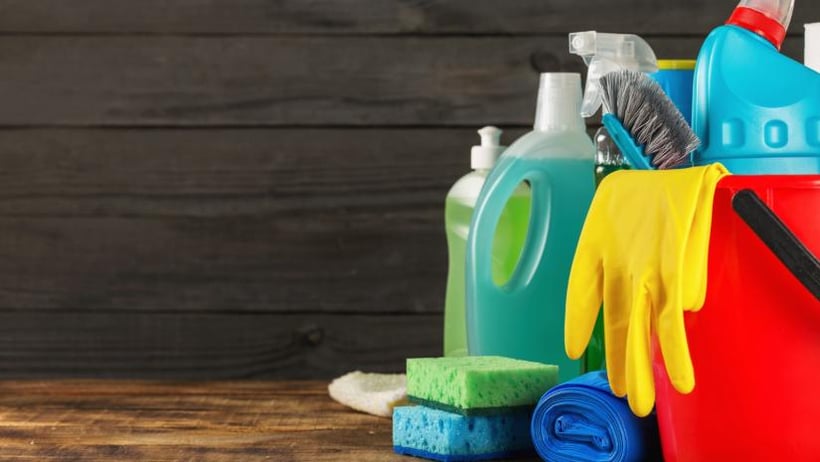
Safeguarding the integrity of the Canadian food industry is an ongoing challenge that requires significant guidance in the form of food safety laws and regulations. Among the various measures in place, one crucial aspect that is often underestimated is the pivotal role WHMIS training can play in preventing chemical contamination of food.
This blog post will explore the importance of the online WHMIS course when it comes to preventing chemical contamination, and illustrate how it can serve as a solid platform for averting food-borne illness outbreaks.
Let’s start by discussing the impact of chemical contamination within the food industry.
Chemical Contamination in the Food Industry
Chemical use is widespread in commercial kitchens across Canada today, presenting a significant risk in terms of food contamination. Chemical contamination occurs when food comes into contact with these toxic chemicals, which can lead to chemical food poisoning.
Which Substances Can Cause Chemical Contamination?
Food establishments utilize a variety of chemicals for food preparation, cleaning and sanitizing, all of which can contaminate food if handled incorrectly. Here are some chemical products that are used on a regular basis:
- Acids: Strong corrosives used for cleaning (e.g. hydrochloric or sulfuric acid)
- Aerosols: Non-stick cooking sprays or air fresheners
- Alcohol: High-proof alcohol used in cooking or flambéing
- Ammonia: Corrosive cleaning agent
- Bleach: Corrosive sanitizing agent
- Caustic soda: Heavy-duty cleaner often used for drain clearing
- Cleaning agents: Disinfectants, oven cleaners and degreasers
- Compressed gas cylinders: Carbon dioxide for soda machines or nitrogen for specific cooking methods
- Fire extinguishers: Chemical-based extinguishers
- Pesticides: Sprays or powders used to control pests (flies, cockroaches, rodents, etc.)
All of the above substances are toxic and even small traces of them can cause harm if ingested, making chemical contamination a very serious issue.
How Does Chemical Contamination Occur?
There are several ways in which food can become contaminated by artificial chemicals in a commercial kitchen, and most incidents involve the actions of food handling personnel.
Common mistakes include:
- Improper storage of cleaning agents and other chemical products.
- Using too much detergent or sanitizer to clean food preparation surfaces, utensils, glassware, dishes or cutlery.
- Failing to rinse surfaces, utensils, glassware, dishes or cutlery after cleaning and sanitizing.
- Using kitchen equipment or storage containers made from materials that are not suitable for food or not designed to be reused.
- Improper use of pest control products (e.g. sprays and poisons).
How Can Chemical Contamination Impact Consumer Health?
Regular food poisoning symptoms are the predominant risk associated with the consumption of chemically contaminated food, but there are other serious health issues that can impact unsuspecting consumers.
- Allergic reactions
Some artificial chemicals may trigger allergic reactions that lead to symptoms such as itching, hives, swelling, or respiratory illnesses. - Carcinogenic risks
Certain artificial chemicals have been linked to an increased risk of cancer. Some contaminants are classed as carcinogens and prolonged exposure to these substances in the diet may increase the risk of developing cancer. - Neurological effects
Some artificial chemicals may have adverse effects on the nervous system, leading to issues such as headaches, dizziness, cognitive impairment, and behavioral changes.
How Can You Minimize the Risk of Chemical Contamination?
There are four fundamental steps food businesses should follow in order to mitigate the risks of chemical contamination:
- Labelling and storing chemicals separately from food.
- Choosing the right chemical for the task.
- Following manufacturer instructions regarding dilution, contact time and water temperature.
- Using chemical-based pest control products with extreme care or outsourcing pest eradication procedures to a professional pest control company.
Understanding the Basics of WHMIS
Before we get onto the subject of WHMIS training, let’s get a better understanding of what WHMIS actually is in the context of food preparation and service.
What is WHMIS?
The Workplace Hazardous Materials Information System (WHMIS) is a comprehensive system designed to provide information on hazardous products used in the workplace. This involves classifying these products, ensuring proper labelling, and providing Safety Data Sheets (SDS) to inform workers about potential hazards and safe handling practices.
Is WHMIS a Legal Requirement for Food Businesses in Canada?
In Canada, federal and provincial legislation mandates the implementation of WHMIS protocols. The objective of these laws and regulations is to preserve the health and well-being of staff and consumers. WHMIS guidelines apply to all industries and workplaces including commercial food production facilities and food service establishments where chemicals and other hazardous materials may be used.
WHMIS legislation has been in place in Canada since 1988, with further changes made in 2015 in order to align more closely with global standards. Three key updates were made to the law to bring it in line with the Globally Harmonized System of Classification and Labelling of Chemicals (GHS):
- Labelling Requirements: Aligned with GHS labelling standards, including standardized pictograms and signal words.
- Safety Data Sheets (SDSs): Standardized the format for SDSs to enhance accessibility and understanding.
- Classification Criteria: Adopted internationally recognized criteria for classifying hazardous chemicals.
What Does WHMIS Legislation Include?
Canadian WHMIS legislation centres around three major requirements that can help reduce the risk of chemical contamination in food handling environments:
- Labelling
Hazards must be clearly communicated with key labelling information such as product identifiers, pictograms, signal words, initial supplier identifiers, and workplace labels. - Safety Data Sheets (SDSs)
SDSs must be accessible to all employees and include the details regarding chemical composition, health and safety implications, required safety precautions, and record keeping procedures. In addition, these documents should set out clear guidelines for the safe storage, handling and disposal of hazardous substances. - Training
All staff who encounter hazardous substances in the workplace must undergo professional WHMIS training that covers all the required topics. These include legal frameworks, hazard classification, labelling, SDSs and emergency procedures.
The Role of WHMIS Training
To obtain WHMIS certification in Canada, food industry professionals must complete the relevant training program. This ensures that they are well-versed in the safe handling of dangerous materials. Here’s what students can expect to learn when participating in the online WHMIS course:
-
Identification of Hazardous Materials
The primary objective of WHMIS is to identify and classify hazardous materials. In the context of the food industry, this includes chemicals and substances used in food processing, storage, and transportation. Online WHMIS training equips food industry professionals with the knowledge to identify these materials and understand their potential risks. -
Proper Handling of Chemicals
Many chemicals used in the food industry, such as cleaning agents and sanitizers, can pose serious risks if mishandled. WHMIS training ensures that employees are well-versed in the safe handling, storage, and disposal of these chemicals, minimizing the likelihood of contamination. -
Employee Awareness and Preparedness
Food contamination can often be traced back to lapses in employee awareness and preparedness. Online WHMIS courses empower food industry workers with the information they need to recognize potential hazards and respond appropriately. This not only safeguards the well-being of employees but also contributes to the overall safety of the food supply chain.
The Advantages of Online WHMIS Training
The online WHMIS course is the hassle-free way to improve food safety and legal compliance. Sign up today and benefit from the following:
-
Accessibility and Convenience
Online WHMIS training offers unparalleled accessibility and convenience. Food industry professionals can undergo training at their own pace, without it getting in the way of their day-to-day work. This flexibility is particularly beneficial for businesses with complex operations and diverse work schedules. -
Consistent Training Standards
Standardization is key in maintaining a high level of safety across the food industry. Online WHMIS courses ensure consistent training standards for all employees, regardless of their location or role within the organization. This uniform approach is crucial in preventing lapses that could lead to food contamination. -
Cost-Effective Compliance
Traditional training methods can be resource-intensive, requiring businesses to invest significant amounts of time and money. Online WHMIS training offers a cost-effective alternative without compromising the quality of education. This is especially advantageous for small and medium-sized enterprises looking to prioritize food safety within budget constraints.
Measuring The Impact of WHMIS Training
Ensuring the effectiveness of any training program involves evaluating its impact. Let's consider some of the key metrics that can be used to measure the success of the WHMIS course.
-
Incident Reports
Monitor incident reports related to hazardous materials in the workplace. A decrease in incidents after the implementation of WHMIS training suggests that employees are applying their knowledge to prevent and manage potentially dangerous situations. -
Compliance Audits
Conduct regular compliance audits to ensure that WHMIS protocols are being followed in the workplace. This includes verifying the proper labelling of hazardous materials, the availability of safety data sheets, and adherence to safe handling practices. An increase in compliance rates indicates that the training is translating into real-world practices. -
Knowledge Retention
Assess the retention of knowledge by periodically quizzing employees on WHMIS principles in the months following their initial training. This can reveal whether the information is sticking with employees over the long term or if there's a need for regular refresher courses. -
Integration with Safety Protocols
Evaluate how well WHMIS principles are integrated into daily safety protocols. For instance, are employees consistently applying proper labelling when handling hazardous materials? This metric assesses the practical application of training in real-life scenarios. -
Reduction in Chemical-Related Health Issues
Monitor health-related issues attributed to chemical exposure in the workplace. A decrease in such incidents indicates that employees are effectively applying WHMIS training to protect their health and well-being. -
Cost Savings
Analyze the cost savings achieved through a reduction in incidents, accidents, and health issues. Reducing the number of incidents that occur will in turn reduce the costs associated with medical treatment, legal issues, and potential damage to the company's reputation. -
Training Records
Maintain a comprehensive audit trail of training records, documenting who completed WHMIS training and when. This not only ensures compliance with regulatory requirements but also serves as a valuable resource during internal and external inspections.
By actively monitoring these metrics, you not only ensure the success of your WHMIS training initiatives but also contribute to the overall safety culture within your food business. Remember, the goal is not just to meet regulatory standards but to continually enhance the safety of your workforce and the integrity of the food businesses in Canada.
What Happens if You Don’t Comply With WHMIS Legislation?
There are a number of legal ramifications that can materialize in the event of a WHMIS violation, including fines, imprisonment and business closures.
The fines imposed can be particularly damaging for small and medium-sized businesses. The government has the power to penalize offenders in the following ways:
- Federal: Fines of up to $1 million (CAD) and a maximum sentence of two years in prison.
- Provincial: Equivalent penalties and prison terms, plus potential licence suspensions and temporary business closures.
If injury or illness is caused by a breach of WHMIS regulations, the offending business may also have to deal with a costly civil lawsuit.
How Can Businesses Avoid Breaching WHMIS Legislation?
There are several common causes when it comes to WHMIS violations, but most of them can be mitigated by taking the following actions:
- Effective hazard communication: Set clear guidelines for managing hazardous materials
- Adequate labelling: Label items clearly with the relevant WHMIS symbols and information.
- Accurate records: Create and maintain records regarding SDS, WHMIS training and incidents involving hazardous products. The identity and quantity of all hazardous substances in the workplace should also be documented.
- Professional training: The online WHMIS course equips food industry personnel with the necessary knowledge and skills for the proper handling, storage, and disposal of hazardous substances. It also outlines the steps that should be taken in the event of an incident involving such materials.
Take the Next Step on the Path to WHMIS Certification
Ready to enhance the safety protocols in your food business? Sign up to receive notifications about our upcoming WHMIS training programs, and our team will reach out to you with more information as soon as it's available.
Get in touch with the Canadian Institute of Food Safety (CIFS) today and discover how professional WHMIS training can help prevent chemical contamination in your workplace.
Sign Up
To receive notifications about our upcoming WHMIS training programs, complete the form below and our team will reach out to you with more information as soon as it's available.




